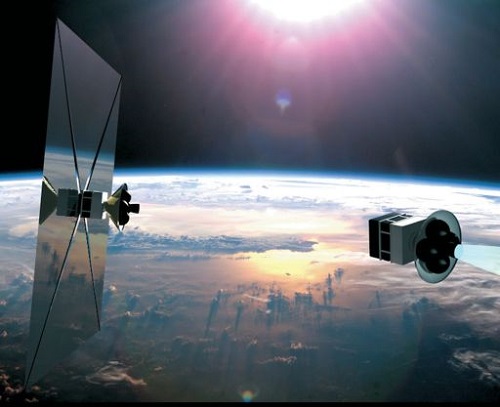India can take great pride in the successful insertion of its Mangalyaan Mars probe into orbit around the red planet. At a cost of $75 million, the spacecraft is a bargain — Maven, which entered Mars orbit on Sunday, cost almost ten times as much. In an Associated Press story this morning, I noticed that B. N. Raghunandan (Indian Institute of Science) said that every time India launches another rocket, he is besieged with students asking how they can enter his school’s aerospace program. It’s the same effect I was talking about yesterday, in which inspirational achievements drive cultural perceptions and influence careers.
Meanwhile, I want to tackle solar sails this morning, prompted by Les Johnson’s presentation at the 100 Year Starship Symposium in Houston last week. What caught my attention here was the positive news Les had to share about what’s ahead in the pipeline. But to put it into context, let’s think about what has already flown in space. The Russian ‘sail mirror’ experiments called Znamya were pitched as an attempt to light up Siberian cities at night, but of course can be considered experiments in sail deployment, the first successful in 1993, the second a failure when it became entangled on an antenna on the Mir space station.

Image: Les Johnson (left) and Al Jackson. The latter, by the way, presented some startling ideas in Houston about how an extraterrestrial culture might use astronomical objects — including neutron stars and black holes — as ways of flagging its existence to other cultures. Al is writing up these SETI ideas for a future article on Centauri Dreams.
Since then we’ve had IKAROS, which flew as a secondary payload on a Venus mission, was spin-deployed, and is still active in and around the orbit of Venus. This is a story that caught a lot of people by surprise. I remember when I was watching the launch of this mission online and my wife came into the room. Looking over my shoulder, she asked what I was watching. “The Japanese are launching a solar sail,” I replied. She was headed out of the room as I responded, then came back. “You’re kidding,” she said, and just stood there watching.
The early success of IKAROS was a surprise to me because we had seen ground deployment experiments from NASA as well as from DLR, the German Aerospace Center, and a lot of us took our eye off what was going on with JAXA, the Japanese space agency. IKAROS was and is a thumping success, and one that deployed an ingenious electro-optical material to vary the brightness of parts of the sail in order to maneuver. That gets around trying to ‘tack’ the sail as one would with a conventional wind sail on the ocean, and Johnson said it was a marker for the future — the plan will be to avoid mechanical systems wherever possible, to keep things simple.
NASA’s NanoSail-D sails were actually cut down from one of the earlier 20 square meter ground deployment test sails, the first launched and lost in the attempt, the second (NanoSail-D2) successfully achieving orbit. Keep in mind that NanoSail-D, a 10 square meter sail, was not only a deployment test but also a look at how satellites might be de-orbited, using a small sail to create enough atmospheric drag to cause the satellite to burn up upon re-entry. There was no NanoSail model A, B, or C, by the way — the D has been variously said to stand for ‘demonstrate,’ ‘deploy,’ ‘drag,’ and ‘de-orbit,’ so you can take your pick.
And look at everything that’s coming up. The Planetary Society’s CubeSat-based sails, LightSail-A and LightSail-B, both using an aluminized 4.5 micron mylar film and sails of 32 square meters is on the horizon. We’re looking at April of next year for the first LightSail launch, which could well herald the era of small CubeSat missions driven by sail propulsion to Mars and other planets. NASA’s Sunjammer is also in the mix, though I’m waiting on a clarification from the builders as to its flight status.
Beyond LightSail, we have three different versions ranging in size up to 50 square meters of the European Space Agency’s Gossamer sail, the first of which has already been built and is awaiting a launch date. Developed in tandem with Germany’s DLR, the sails are designed as technological demonstrators with increasing levels of complexity in a scalable design. The first deployment will be of a 5 meter by 5 meter sail in a 320 kilometer Earth orbit, to be documented by at least four onboard cameras. The intermediate sail is 20 X 20 meters.

Image: The ESA/DLR Gossamer sail in an artist’s impression. Credit: ESA.
I’ll be looking in future days at some of the other possibilities, which include the University of Surrey’s CubeSail, with three CubeSat sail missions slated to fly in the next three years (emphasis here on de-orbiting spacecraft in low-Earth orbit), and the CubeSat-based Near Earth Asteroid (NEA) Scout, a solar sail prospector designed for eventual rendezvous with multiple NEAs to evaluate their possibilities for mining. And then there’s Lunar Flashlight, a CubeSat mission out of the Jet Propulsion Laboratory and Marshall Space Flight Center which will orbit the lunar poles to look for signs of water at the south pole.
As to JAXA: The long-range plan is to develop a joint ion propulsion/sail mission to the outer planets, so it’s clear that Japan will remain a force to be reckoned with in sail technology
Johnson pointed out that the key for our future sail ambitions is to learn how to make large sails in space. The worst place to work on a sail is on the ground, in a gravity well — we have to launch and safely deploy these huge structures. Most people watching the sail scene believe that we’ll ultimately be building sails that dwarf these early efforts in space using materials we’ve harvested from the asteroids. Then we can start the ramping up of sail technologies for true interstellar precursors.



LightSail Sails through Day-in-the-Life Test
Posted by Jason Davis
2014/09/24 20:49 UTC
Topics: Planetary Society Projects, LightSail
There were smiles, laughs and sighs of relief on the campus of Cal Poly San Luis Obispo last night, as The Planetary Society’s LightSail spacecraft unfurled its solar sails and passed a major systems test. The so-called day-in-the-life test demonstrated LightSail can autonomously perform its key functions in space, starting from the moment the spacecraft is ejected from its P-POD (Poly Picosatellite Orbital Deployer).
While there is still much work to be done before the team decides whether or not to send LightSail-A on a 2015 shakedown flight, Tuesday’s test sent the spacecraft over a big project hurdle—and gave the team a much-needed morale boost.
Full article here:
http://www.planetary.org/blogs/jason-davis/2014/20140924-lightsail-sails-ditl.html
Johnson pointed out that the key for our future sail ambitions is to learn how to make large sails in space.
Back to the future. Eric Drexler was talking about this in the early 1980’s, before switching over to nano-tech. I agree that this is a sensible approach and I would like to hear about the current thinking about this. Drexler wanted to spray aluminum onto a wax surface and evaporate the wax off, leaving a very thin aluminum film. Since then we have new materials like graphene as a structural material, plus the possibility of using meshes for microwave beams, rather than fairly solid sails (but see Zubrin and perforated sails) for sunlight and lasers. Is the JAXA approach the best way to make solid state steering, or might MEMS be an alternative approach?
Good idea, but one has to ask how the wax surface is made in the first place. Also, wax is probably much harder to come by in space than aluminum.
“Spray” is also not quite the right word. In the vacuum of space you would advantageously use chemical vapor deposition (CVD) to create thin surfaces. I think that is what Eric Drexler was talking about. CVD can create aluminum, diamond, and all sorts of other films with precise control of thickness. Maybe even graphene, I don’t know. Perhaps you could deposit onto a rotating non-stick drum and peel it off to create a continuous strip of sail.
@Eniac – I should have put spray in quotes. I don’thave Drexler’s article to hand, but Friedman writes in “Starsailing” that the aluminum is evaporated in vacuum to form a thin film on a soaplike bubble that would disappear. That sounds like CVD.
The thickness was to be as little as 0.1 microns (that is 45x thinner than the aluminized Kapton sails that the Planetary society is using) although it did need to be supported on a “spiderweb” of supports for strength. Acceleration of the sail would have been 8 mm/s^2 – not bad at all.
@Eniac
‘“Spray” is also not quite the right word. In the vacuum of space you would advantageously use chemical vapor deposition (CVD) to create thin surfaces.’
PVD (physical vapour deposition) can be used in which atoms are sputtered off a solid source for instance and they then impact and stick to another material. Low velocity particle beams can also be used, maybe even depositing radioactive material for a fission fragment sail. Graphene shows great promise, these very thin sheets can be electrostatically manipulated and stuck together with vaporised materials.
@Alex Tolley
‘Is the JAXA approach the best way to make solid state steering, or might MEMS be an alternative approach?’
I suspect an electric charge change to change the reflectance or shape of the material would be of use here.
I sent in to this forums editors the new ideas of lunar flashlight and NEO scout, these projects are new and meant to ride along with SLS upper stages.
I have been kicking around an enhanced version of these projects that involves keeping alive the upper stage long enough to perform another burn after releasing the human crew.
could this shorten the 2.5 trip time for the solar sail powered cubesats?
http://yellowdragonblog.com/2014/08/09/sls-em-1-upper-stage-as-experimental-flight-test-bed-lunar-free-return-flight/
ULA recently sent into solar orbit two Centaurs from classified missions
I’m wondering if there is a role here for 3d printers or does vapour deposition win hands-down? Maybe 3d printing could be utilised on the ISS based on a continuous process to produce rolls of desired length of material (ideal for helio-gyro design?). Perhaps a suitable extrudable polymer could be designed that held a colloidal suspension of, say, aluminium nano-particles ( https://www.youtube.com/watch?v=6zurHSq4CB4 ) so that a thin mesh could be printed for a microwave-beamed sail, although I’m not sure if the technology would permit a thin enough visible-light sail to be constructed due to the thicknesses required for that type and reflectivity.
Perhaps these various methods should be designed into any future sail missions so that any repairs could be performed en-route… ISM erosion too great on vane ’16 beta’?… no problem, detach said shredded sail sub-component and print a replacement to be hauled into place. Not too sure if the bulk mass of printer raw-material would be prohibitive.
More LightSail Day-in-the-Life Multimedia, and a Community Image Processing Challenge
Posted by Jason Davis
2014/09/30 18:07 UTC
I’ve had a couple days to organize all of the great photos and videos we captured last week during LightSail’s successful day-in-the-life test. In my previous update, I posted the raw deployment video from our primary high-def camera. It takes three minutes and 40 seconds for the sail booms to extend to 90 percent, and while some viewers found the sequence hypnotic, a few got bored—with one commenter saying it was like watching grass grow. If you’re in the latter group, this is the video for you:
Full article here:
http://www.planetary.org/blogs/jason-davis/2014/20140930-more-lightsail-ditl-media.html